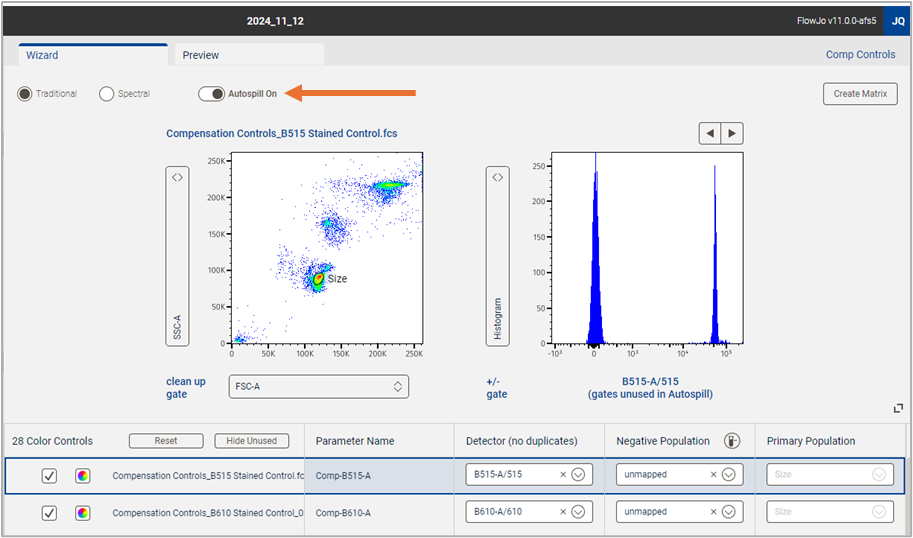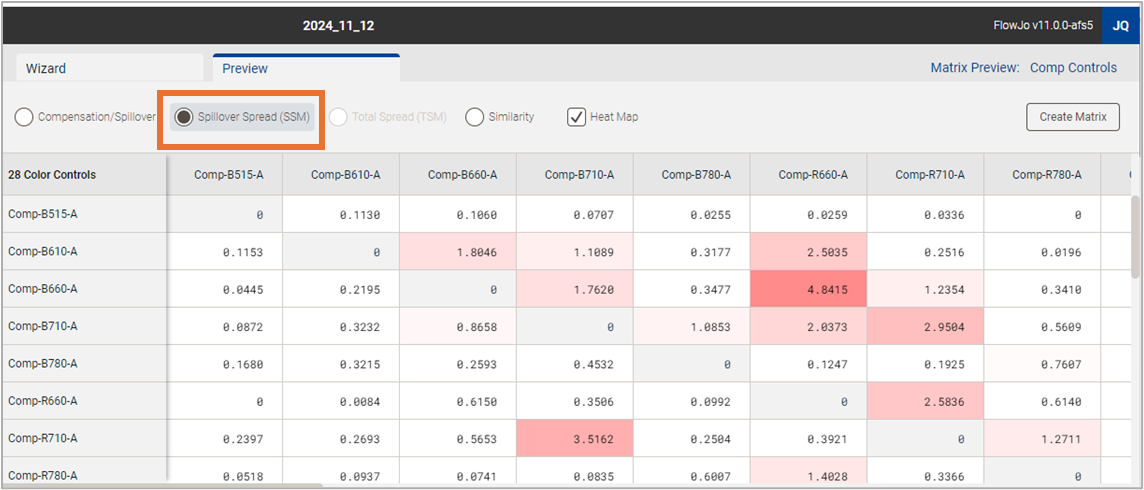AutoSpill is an algorithm for calculating a spillover matrix using linear regression rather than matching MFI values on gates. It can be used with either spectral unmixing or compensation.
AutoSpill was developed in collaboration with researchers from the Vlaams Instituut voor Biotechnologie in Belgium and the the Babraham Institute in Cambridge, UK. This form of gate-less compensation removes some of the requirements of traditional compensation making the overall process easier and more robust. The algorithm combines FlowJo's automatic clean-up gating with linear regression through an iterative process that helps reduce error and improve the spillover matrix.
The AutoSpill option can be found in the unmixing wizard, as shown in Figure 1. When the option is selected FlowJo will use AutoSpill to produce the spillover matrix. If deselected, a traditional gate-based approach will be used.

Figure 1 AutoSpill selection tool
Set up
Using AutoSpill has a similar setup to gate-based unmixing. Single stain controls must first be loaded into the compensation group, the Compensation context must be selected, and the Wizard option must be chosen. As AutoSpill is on by default, the process resolves to making sure the choice between spectral and traditional is properly selected, single stain controls have been properly assigned to parameters, and the clean-up gates look appropriate. Unlike traditional compensation, the AutoSpill method does not require gated positive and negative populations, as the algorithm will determine its own positive populations. You will notice the far right column in the sample assignment panel is labeled Primary Population, instead of Positive Population when AutoSpill is used, indicating that a positive population is not being used.
Algorithm
Gate based unmixing / compensation uses the median fluorescent intensity (MFI) of the positive and negative population of a single stain control, with positive and negative defined on the primary detector, to estimate the values in the spillover matrix. Proper unmixing/compensation is achieved when the MFI's of the positive and negative populations are equal for all secondary detectors. AutoSpill replaces this approach by fitting a robust regression line through all of the data points in the clean-up group and adjusting them until the slope of that line in reference to any secondary detector is flat.
The resulting AutoSpill matrix is directly comparable to a matrix produced using gates and will appear in a list of all matrices when either completed or previewed.
Autofluorescence Extraction
Autofluorescence can be estimated by using unstained cells associated with the cells using an unstained control to create a parameter. An unstained control can be added to an empty detector (a detector with no stain associated with it) when making parameter assignments in the wizard. Any deviation from a zero slope regression line is attributed to autofluorescence and encoded into a new parameter.
AutoSpread
AutoSpill requires a modified algorithm for calculating the Spillover Spreading Matrix (SSM). The traditional calculation requires a defined positive and negative population to calculate the extent of spreading on the positive population versus the negative population. If AutoSpill is used, FlowJo will automatically use the AutoSpread algorithm, which applies a linear model to derive spillover values and create a matrix directly comparable to a traditional SSM. The Spillover Spreading Matrix can be displayed for any type of unmixing/compensation matrix by selecting the “SSM” radio button above the compensation matrix in the preview window, as shown in figure 2.

Figure 2 AutoSpread matrix
Read the full article
AutoSpill: a method for calculating spillover coefficients in high-parameter flow cytometry.
Authors: Carlos P. Roca, Oliver T. Burton, Teresa Prezzemolo, Carly E. Whyte, Richard Halpert, Łukasz Kreft, James Collier, Alexander Botzki, Josef Spidlen, Stéphanie Humblet-Baron, Adrian Liston.
